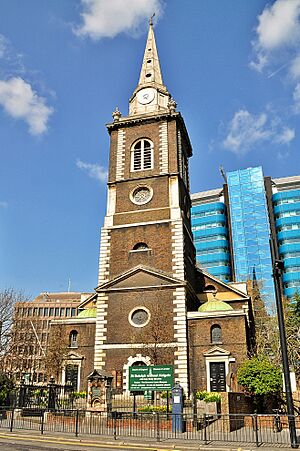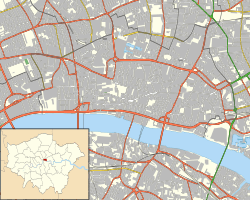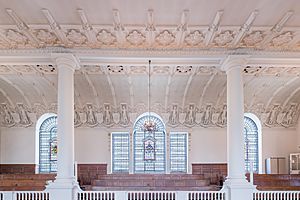St Botolph's Aldgate facts for kids
Quick facts for kids St Botolph's Aldgate |
|
|---|---|
| St Botolph without Aldgate and Holy Trinity Minories | |
 |
|
| 51°30′50″N 00°04′34″W / 51.51389°N 0.07611°W | |
| Location | London, EC3 |
| Country | England |
| Denomination | Church of England |
| Previous denomination | Roman Catholic |
| Churchmanship | Liberal / Modern Catholic |
| History | |
| Status | Active |
| Architecture | |
| Functional status | Parish church |
| Heritage designation | Grade I listed building |
| Architect(s) | George Dance the Elder |
| Architectural type | Georgian architecture |
| Years built | 1115; 16th century; 1741 |
| Completed | 1744 |
| Administration | |
| Parish | St Botolph without Aldgate |
| Deanery | City of London |
| Archdeaconry | London |
| Episcopal area | Two Cities (London and Westminster) |
| Diocese | London |
St Botolph's Aldgate is a Church of England church in London. It is a parish church, meaning it serves a specific local area. The church stands just outside the old London Wall, which once protected the City of London. This location makes it part of the East End of London.
The church's full name is St Botolph without Aldgate and Holy Trinity Minories. Sometimes people just call it Aldgate Church. In 1899, its parish joined with the nearby Church of Holy Trinity, Minories.
The building you see today was built in the 1700s. It is made of brick with stone details around the corners and windows. The church has a square tower with a tall, pointed spire on top.
Contents
Where is St Botolph's Aldgate?
The church is located where two streets, Houndsditch and Aldgate High Street, meet. It is about 30 yards outside where the old Aldgate gate used to be. This gate was a strong defensive entrance in the London Wall.
Why is it called St Botolph's?
St Botolph's Aldgate is one of four churches in medieval London named after Saint Botolph. He was a saint from the 7th century. All these churches were built near one of the City's main gates.
The other churches named after Saint Botolph were:
- St Botolph-without-Bishopsgate (near Bishopsgate)
- St Botolph's Aldersgate (near Aldersgate)
- St Botolph's, Billingsgate (near London Bridge, but this church was destroyed in the Great Fire of London in 1666 and never rebuilt).
It is thought that the church outside Aldgate was the first in London to be named after Saint Botolph. The others followed soon after.
Saint Botolph and Travel
By the late 1000s, Saint Botolph was seen as the patron saint of boundaries, trade, and travel. This connection to travel was very important before the legend of Saint Christopher became popular. This is likely why churches built near city gates were dedicated to him. They were places where travelers would pass through.
History of the Church
Early Years
The first written record of St Botolph's Aldgate is from 1115. At that time, it became part of the Holy Trinity Priory, Aldgate. This priory was a religious house founded by Matilda of Scotland, who was the wife of King Henry I of England. However, the church itself might have been founded even earlier, before 1066.
The church was rebuilt in the 1500s by the leaders of the Holy Trinity Priory. It was also updated in 1621. Luckily, it survived the Great Fire of London in 1666. In the early 1700s, people described it as an "old church" made of brick, rubble, and stone, built in a "Gothick" style. It was about 78 feet long and 53 feet wide. It also had a tower that was about 100 feet tall with six bells.
The 18th Century Rebuild
St Botolph's was completely rebuilt between 1741 and 1744. The new design was created by George Dance the Elder, a famous architect. The outside of the church is made of brick with stone details. The tower is also brick and has a stone spire.
Inside, the church has a main area called the nave and two side areas called aisles. These are separated by large pillars that hold up a flat ceiling. There are balconies, called galleries, along three sides of the church. Light comes in through two rows of windows on each side wall, one above and one below the galleries. All the old monuments from the previous church were saved and put back into the new building.
The 19th Century and Beyond
In the late 1800s, the inside of the church was redecorated by John Francis Bentley. He was the architect who designed Westminster Cathedral.
The churchyard, which is the land around the church, has been used since 1230. By 1875, it became a public park. In 1892, a landscape designer named Fanny Wilkinson turned it into a public garden. A drinking fountain was added in 1906 to remember a kind person named Frederic David Mocatta.
In 1899, St Botolph's parish joined with Church of Holy Trinity, Minories. From that church, St Botolph's received a preserved head. People believed it belonged to Henry Grey, 1st Duke of Suffolk. He was executed for treason by Queen Mary I in 1554. In 1990, during an archaeological dig in the church's crypt, a preserved head was found. It was then buried in the churchyard.
World War II and Restoration
During World War II, the church was badly damaged several times by bombs during the Blitz. On January 4, 1950, it was given a special status as a Grade I listed building. This means it is a very important historical building.
After being repaired, the church was damaged again by a fire in 1965. This meant even more repairs were needed.
St Botolph's was officially reopened on November 8, 1966. The Bishop of London led the ceremony. Queen Elizabeth The Queen Mother and the Lord Mayor of London, Sir Robert Bellinger, were also there.
In the early 1970s, the church's crypt (an underground room) was used as a shelter for homeless people at night. During the day, it was a youth club for Asian boys.
The Historic Organ
The church has a very old organ built by Renatus Harris in the early 1700s. It has been carefully restored to how it was in 1744, using many of its original parts. This organ is considered the oldest church organ in the United Kingdom. While some churches have older pipes or cases, this is the oldest collection of pipes still in their original places on their original wind chests. Because it is so important, the organ was filmed for a documentary called The Elusive English Organ.
The organ was first given to the church by Thomas Whiting in 1676. It was built between 1702 and 1704. Harris's son-in-law, John Byfield, improved it for the current church building in 1740. The organ was made much bigger several times in the 1800s and rebuilt again in the 1960s.
In 2002, St Botolph's decided to restore the organ. They raised money for the project. The restoration took nine months and was finished in May 2006.
Famous People Connected to St Botolph's
- Daniel Defoe, the writer who wrote Robinson Crusoe, was married in this church in 1683.
- Thomas Bray, who started the SPCK (a group that helps spread Christian education), was the church's rector from 1706 to 1730.
Images for kids





